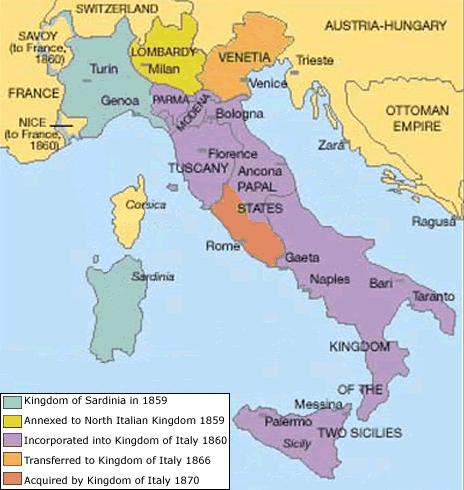Italian Unification Map
Italy as formed during the Risorgimento
 Across several centuries a succession of Dukes from the dynastic
House of Savoy had been able
to achieve a greater territorial sway and diplomatic importance, most notably as a reward
for successful participation in coalitions contesting key dynastic successions in western Europe,
eventually becoming recognised as being Kings of Sardinia. Across several centuries a succession of Dukes from the dynastic
House of Savoy had been able
to achieve a greater territorial sway and diplomatic importance, most notably as a reward
for successful participation in coalitions contesting key dynastic successions in western Europe,
eventually becoming recognised as being Kings of Sardinia.
The extent of the Kingdom of Sardinia as at 1859 is indicated
on this map its principal territories being the island of Sardinia, together with the mainland provinces
of Piedmont (chief city - Turin), Savoy, Nice and Genoa.
Also shown on this map are the outlines of several historic dynastic states,
the Venetian Republic, and the territories long under Papal sovereignty, that
were to be variously annexed, incorporated, gained by diplomatic transfer, or acquired as a Kingdom
of Italy, which had the historic city of Rome as its capital, gradually grew into being between 1859 and 1870.
Nice and Savoy were lost to the Sardinian Kingdom as a
part of the price of securing the assistance of the French ruler Napoleon III in gaining the immensely rich
province of Lombardy in 1859. The Sardinian Kingdom subsequently restyled
itself as having become a "North Italian Kingdom" and, after further extensive incorporations of territory in
1860, an actual Kingdom of Italy was proclaimed.
The "Italian" nationalism that was offering support to the dynastic House of Savoy in
integrating what it was seen as "Italian" territory was keen to see the historic city of Rome brought into "Italia" - as its
capital - whilst
the Papacy was resolutely determined to retain its very longstanding sovereign and territorial
independence.
The resulting "Roman Question" was
dramatically answered in 1870 when the French power, that had been protecting Papal Rome against the
aspirant Italian Unification - Risorgimento process, was abruptly withdrawn to participate in that pressing
situation arising from the outbreak of the Franco-Prussian War in more northerly parts of Europe allowing
the Kingdom of Italy to forcibly seize control. A plebiscite was subsequently held in which the inhabitants
of the territories so acquired endorsed their incorporation into the Italian Kingdom.
The then, and later Popes, witheld their assent to this seizure of Rome until Lateran Agreements of 1929
recognised the Vatican City as being an independent state under Papal Sovereignty.
A fairly informative consideration of the history of the Italian Unification - Risorgimento
chain of events, and the influential personalities and the socio-political forces involved,
is available by following our
' Italian Unification. Cavour, Garibaldi
and the Making of Italy ' link (available further down this page):-
Popular European History pages
at Age-of-the-Sage
The preparation of these pages was influenced to some degree by a particular "Philosophy
of History" as suggested by this quote from the famous Essay "History" by Ralph Waldo Emerson:-
There is one mind common to all individual men...
Of the works of this mind history is the record. Its genius is
illustrated by the entire series of days. Man is explicable by
nothing less than all his history. Without hurry, without rest,
the human spirit goes forth from the beginning to embody every
faculty, every thought, every emotion, which belongs to it in
appropriate events. But the thought is always prior to the fact;
all the facts of history preexist in the mind as laws. Each law
in turn is made by circumstances predominant, and the limits of
nature give power to but one at a time. A man is the whole
encyclopaedia of facts. The creation of a thousand forests is in
one acorn, and Egypt, Greece, Rome, Gaul, Britain, America, lie
folded already in the first man. Epoch after epoch, camp,
kingdom, empire, republic, democracy, are merely the application
of his manifold spirit to the manifold world.
- 1 The European Revolutions of 1848 begin
- A broad outline of the background to the onset of the turmoils and a consideration of some of the early events.
- 2 The French Revolution of 1848
- A particular focus on France - as the influential Austrian minister Prince Metternich, who sought to encourage the re-establishment of "Order" in the wake of the French Revolutionary and Napoleonic turmoils of 1789-1815, said:-"When France sneezes Europe catches a cold".
- 3 The Revolution of 1848 in the German Lands and central Europe
- "Germany" had a movement for a single parliament in 1848 and many central European would-be "nations" attempted
to assert a distinct existence separate from the dynastic sovereignties they had been living under.
- 4 The "Italian" Revolution of 1848
- A "liberal" Papacy after 1846 helps allow the embers of an "Italian" national aspiration to rekindle across the Italian Peninsula.
- 5 The Monarchs recover power 1848-1849
- Some instances of social and political extremism allow previously pro-reform conservative elements to support
the return of traditional authority. Louis Napoleon, (who later became the Emperor Napoleon III), attains to power
in France offering social stability at home but ultimately follows policies productive of dramatic change in the wider European
structure of states and their sovereignty.
|
|
|
![[italy unification map]](../local/enlightenment.gif)
![[italy unification map]](../local/enlightenment.gif)